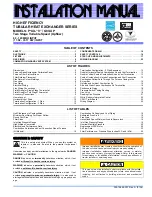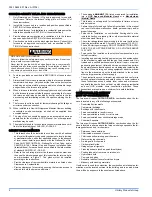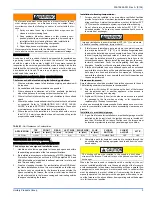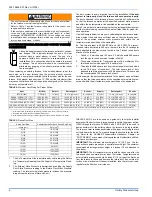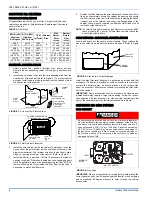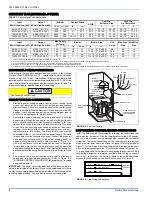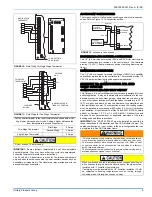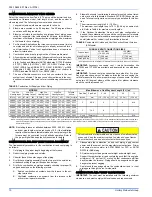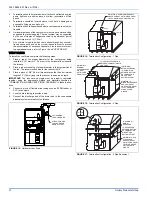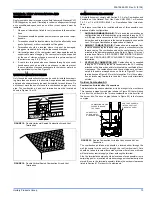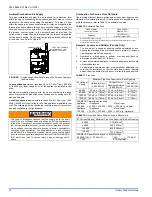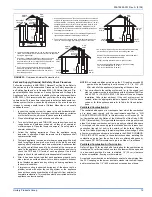
035-19624-001 Rev. A (0104)
Unitary Products Group
7
GAS PIPING INSTALLATION
Properly sized wrought iron, approved flexible or steel pipe must be
used when making gas connections to the unit. If local codes allow the
use of a flexible gas appliance connection, always use a new listed con-
nector. Do not use a connector that has previously serviced another gas
appliance.
Some utility companies or local codes require pipe sizes larger than the
minimum sizes listed in these instructions and in the codes. The furnace
rating plate and the instructions in this section specify the type of gas
approved for this furnace - only use those approved gases. The instal-
lation of a drop leg and ground union is required. Refer to Figure 7.
IMPORTANT:
An accessible manual shutoff valve must be installed
upstream of the furnace gas controls and within 6 feet (1.8 m) of the fur-
nace.
The furnace must be isolated from the gas supply piping system by
closing its individual external manual shutoff valve during any pressure
testing of the gas supply piping system at pressures equal to or less
than 1/2 psig (3.5 kPa).
Gas piping may be connected from either side of the furnace using any
of the gas pipe entry knockouts on both sides of the furnace. Refer to
Figure 1 dimensions.
GAS ORIFICE CONVERSION FOR PROPANE (LP)
This furnace is constructed at the factory for natural gas-fired operation,
but may be converted to operate on propane (LP) gas by using a fac-
tory-supplied LP conversion kit. Follow the instructions supplied with
the LP kit. Refer to Table 6 or the instructions in the propane (LP) con-
version kit for the proper gas orifice size.
HIGH ALTITUDE GAS ORIFICE CONVERSION
This furnace is constructed at the factory for natural gas-fired operation
at 0 – 2,000 ft. (0 m – 610 m) above sea level.
The gas orifices on this furnace must be changed in order to maintain
proper and safe operation, when the furnace is installed in a location
where the altitude is greater than 2,000 ft. (610 m) above sea level on
natural gas or the altitude is greater than 4,000 ft. (1219 m) above sea
level on propane (LP) gas. Refer to Table 6 or the instructions in the
high altitude conversion kit for the proper gas orifice size.
The unit may also be converted for altitudes up to 10,000 ft. (3048 m)
on natural and propane (LP) gas with additional derate as shown in
Table 6 or refer to ANSI Z223.1 NFPA 54 National Fuel Gas Code or in
Canada CAN/CGA-B149.1-00 Natural Gas and Propane Installation
Code.
HIGH ALTITUDE PRESSURE SWITCH CONVERSION
For installation in locations where the altitude is less than 4,500 feet
(1372 m), it is not required that the pressure switch be changed, pro-
vided the maximum vent/intake pipe lengths are adjusted as shown in
the notes to Table 9. For altitudes above 4,500 feet (137 m), refer to
Instructions in the Accessory High Altitude Kit.
FIGURE 7:
Gas Piping
The gas valve body is a very thin casting that cannot take any
external pressure. Never apply a pipe wrench to the body of the gas
valve when installing piping. A wrench must be placed on the octa-
gon hub located on the gas inlet side of the valve. Placing a wrench
to the body of the gas valve will damage the valve causing improper
operation and/or the valve to leak.
CHECKING THE GAS PRESSURES
1.
The pressure ports on the gas valve are on the inlet and outlet-
sides of the valve. The inlet port is sealed with a 1/8" NPT plug.
2.
The manifold pressure must be taken at the outlet port.
3.
The inlet gas supply pressure must be taken at the inlet port.
IN P.
4.
Remove the 1.8" (3.175 mm) NPT plug on the inlet port of the
gas valve using a 1/8" Allen wrench. Insert a 1/8" (3.175 mm)
NPT to 1/4" (6.35 mm) hose fitting in to the inlet port .
5.
Remove the tube on the outlet side of the gas valve. Use a tee
and a short piece of tubing to reconnect the tube to the gas
valve.
6.
Use a 12" ( 304.8 mm) piece of 1/4" ( 6.35 mm) tubing to con-
nect the tee with the positive side of the "U" tube manometer or
digital pressure measuring equipment.
TABLE 5:
Inlet Gas Pressure Range
INLET GAS PRESSURE RANGE
Natural Gas
Propane (LP)
Minimum
4.5” W.C. (1.12 kPa)
8.0” W.C. (1.99 kPa)
Maximum
10.5” W.C. (2.61 kPa)
13.0” (3.24 kPa) W.C.
DRIP
LEG
GROUND JOINT UNION
MAY BE INSTALLED
INSIDE OR OUTSIDE UNIT.
EXTERNAL MANUAL
SHUTOFF VALVE
TO GAS
SUPPLY
TO GAS
SUPPLY
TABLE 6:
High Altitude Conversion
Type
Of Gas
Orifice at
Sea Level
2,000 ft.
(610 m)
3,000 ft.
(914 m)
4,000 ft.
(1219 m)
Natural
#45
#46
#47
#47
Propane
#55
#55
#55
#55
Type
Of Gas
5,000 ft.
(1524 m)
6,000 ft.
(1829 m)
7,000 ft.
(2134 m)
8,000 ft.
(2438 m)
Natural
#47
#48
#48
#49
Propane
#56
#56
#56
#56
Type
Of Gas
9,000 ft.
(2743 m)
10,000 ft.
(3048 m)
Natural
#49
#50
Propane
#56
#57
PROPANE AND HIGH ALTITUDE CONVERSION KITS
It is very important to choose the correct kit and/or gas orifices for
the altitude and the type of gas for which the furnace is being
installed.
Only use natural gas in furnaces designed for natural gas. Only use
propane (LP) gas for furnaces that have been properly converted to
use propane (LP) gas. Do not use this furnace with butane gas.
Incorrect gas orifices or a furnace that has been improperly con-
verted will create an extremely dangerous condition resulting in pre-
mature heat exchanger failure, excessive sooting, high levels of
carbon monoxide, personal injury, property damage, a fire hazard
and/or death.
High altitude and propane (LP) conversions are required in order
for the appliance to satisfactory meet the application.
An authorized distributor or dealer must make all gas conversions.
In Canada, a certified conversion station or other qualified agency,
using factory specified and/or approved parts, must perform the
conversion.
The installer must take every precaution to insure that the furnace
has been converted to the proper gas orifice size when the furnace
is installed. Do not attempt to drill out any orifices to obtain the
proper orifice size. Drilling out a gas orifice will cause misalignment
of the burner flames, causing premature heat exchanger burnout,
high levels of carbon monoxide, excessive sooting, a fire hazard,
personal injury, property damage and/or death.

